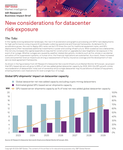The rise of artificial intelligence and cloud computing is fueling an unprecedented expansion of data centers, driving electricity demand to levels the grid was never designed to handle. According to the International Energy Agency, by next year, data centers’ electricity consumption could more than double what it was in 2022 and reach an astounding 1,000 terawatt-hours, roughly the consumption of Japan.
The traditional utility model, which relies on long-term grid expansion to meet demand, is too slow to keep up with this growth. Supply chain constraints, permitting delays, and rising costs make implementing new transmission infrastructure a years-long process. And innovation isn’t willing to wait that long.
One of the most striking examples is the recently announced Stargate project, a venture that claims it will eventually invest up to $500 billion in AI infrastructure, including large-scale data centers powered in part by dedicated renewable energy generation and battery storage.
While some utilities face regulatory and financial constraints in expanding capacity, data centers cannot delay for three to five years waiting on infrastructure upgrades. To support the data center boom, we need to reimagine the data center-utility relationship through innovative approaches to on-site generation, dynamic grid interaction, and strategic power procurement that creates value for both the utilities and data center operators.
Demand response, historically not considered an option for data centers due to their traditionally consistent and predictable loads, is emerging as a key strategy to help them adapt.
The grid can't keep up
According to a report by the Nicholas Institute for Energy, Environment & Sustainability at Duke University, utilities are reporting interconnection wait times up to 10 years. The infrastructure required to move electricity from generation sources to data centers is also lagging, exacerbating regional supply shortages. In key markets like PJM, capacity rates have increased by over 1,000 percent, forcing operators to rethink procurement strategies.
At the same time, power-intensive AI workloads require significantly more energy than traditional cloud computing. Goldman Sachs reports that, on average, ChatGPT queries consume up to 10 times the electricity of Google searches. While DeepSeek’s efficiency gains are promising for the industry, the overall demand trajectory remains upward. Even if the grid could expand capacity, it would struggle to do so quickly enough to meet the needs of AI-driven data centers.
However, demand response can provide immediate relief by allowing data centers to adjust their energy consumption in ways that benefit both their operations and the grid. While data center loads have historically been considered too rigid for demand response, advancements in workload shifting and energy storage make participation not only possible but highly effective. And the benefits to the grid are substantial: new research from Duke University shows that flexibility measures could allow the grid to absorb 76 to 126 gigawatts of new loads.
Rethinking the data center-utility relationship
Data center operators are beginning to realize the financial and operational benefits of participating in grid flexibility programs like demand response, and how they can make the grid more stable. By leveraging on-site resources, transferring non-urgent workloads, and integrating battery storage, data centers can help alleviate grid strain and generate revenue to lower their energy costs.
For instance, Google implemented a system where it adjusts the timing of non-urgent computational tasks to coincide with periods of lower grid demand, ensuring essential functions remain uninterrupted while reducing peak-hour strain on the grid. Similarly, some facilities have begun transferring loads to on-site backup generators during high-demand periods, effectively relieving grid congestion while capitalizing on financial incentives for participation.
Facilities that leverage demand response can offset energy costs, monetize their backup power assets, and reinforce their resilience against grid instability. In highly constrained markets, data centers that participate in demand response enjoy a competitive edge by avoiding expensive peak energy rates while maintaining uptime through strategic energy management. Certain more sophisticated data centers are even attempting to regulate their operations according to carbon intensity of grid power to tailor their operations to their decarbonization strategies. The innovative possibilities for load flexibility in the energy transition are endless.
As more operators recognize these benefits, they realize demand response can work for data centers without disrupting operational integrity. Some are investing in automation that dynamically shifts workloads to align with real-time grid conditions, ensuring that data processing occurs when electricity is abundant and cost-effective. Others are leveraging advanced cooling strategies that adjust power consumption based on grid availability, helping to smooth energy demand fluctuations.
These innovations show that the mindset shift is already taking place to allow data centers to actively contribute to grid stability and efficiency.
The economics of adaptation
As energy demand from data centers skyrockets, utilities and regulators are looking for ways to shift infrastructure costs to large consumers. The Nicholas Institute study reports that soaring capacity prices have forced some states like Georgia and Ohio to implement policies that require data centers to pay a larger share of infrastructure costs.
Long-term power purchase agreements can help hedge against future cost increases, while flexible load management strategies can allow data centers to avoid high-priced peak periods. Localized energy investments, including on-site renewables and storage, can also reduce reliance on grid infrastructure. Some demand response programs also offer a financing component that covers the costs of backup generators or facility control upgrades.
The data center boom isn’t slowing down anytime soon. By taking a new approach to energy procurement and usage, operators can turn their data centers into grid assets, not just loads demanding incremental power. They can make these facilities, which are crucial to the advancement of emerging technologies, become efficient and agile resources for a modern electric system.





